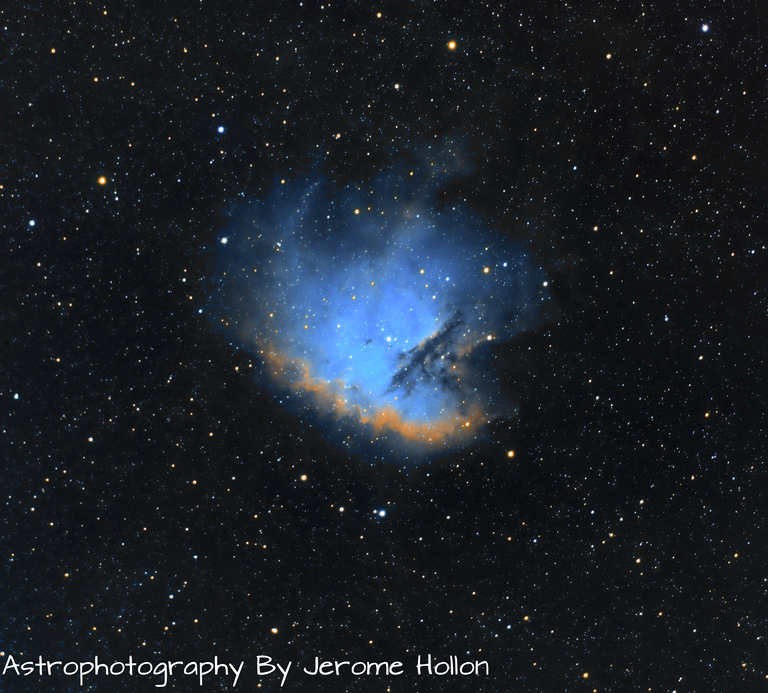
This is a very faint emissions nebula in the constellation of Cassiopeia. It’s so faint that it’s a really difficult object to capture unless you have a really good guiding and dark enough skies to be friendly with long exposures. I was lucky to be able to capture this on a near moonless night, so the skies were dark. I tested out using ten minute exposures on this and it worked out really well I think. This is using my short focal length telescope so it was really easy to guide and keep things solid at 10 minutes. Next time I do a capture with this, I might try for 15 minute exposures.

The nebula is mostly hydrogen gas that is being ionized to glow red by the stars forming around and behind it. The reason it doesn’t look red here is I’ve shot it in narrowband and applied a false color to it. I used what’s called the Hubble palette which assigns a color to three specific emissions spectra. Sulfur II becomes red, Hydrogen Alpha becomes green and Oxygen III becomes blue. In actuality Sulfur and Hydrogen both appear red to us, however, most of the spectrum for hydrogen is too far into the infrared for our eyes to actually see. These monochrome shots get assigned their colors and combined to form an RGB color image. The ions selected by Hubble were selected for the commonality and the colors were chosen to increase contrast. Most of your images from NASA are shot this way.
Check out more details on my personal astrophotography blog: https://www.jeromehollon.com/astro/2022-09-28-ngc-281/
What kind of mount and tracking system do you use to hold those long exposures?
I plan on writing a post about it at some point, I'll talk anyone's ears off about astrophotography.
I use an equatorial mount called iOptron CEM-70-EC that is computerized. I align it with the celestial north pole and then it figures everything else out from GPS and can point to where I want it to go.
Once it's there, I use a technique called "plate solving" to look up the stars in the camera view and reference them against a database of stars to find exactly where the telescope is pointing and give the mount a correction.
The equatorial nature of the mount means that it "tracks" at the rotation rate of the earth. So for every second the earth spins, the mount spins that same amount. It's not perfect though, so once it's trained on sight, I have a secondary camera, called a guide camera help out. It runs at a much higher frame rate, usually 3 second exposures, and picks out the best shaped stars to guide from. When it sees those have moved, i.e. a tracking error, it sends a correction to the mount. With the hope that it can see those stars moving pixel by pixel before the larger, longer focal length big camera can see it.
Those all keep me on target, and then I do a series of exposures, in this case I did 54, 18 for each color that are 10 minutes long each. I then "stack" those images. Stacking is a process where you rotate all the images to the same orientation and average out the pixel values for all of them, throwing out outliers. This lets me reduce noise in the final image, and given how stretched the histograms get for astrophotography, any little bit of noise ends up visible in the final image.
Let me know if you have any more questions about astrophotography! Like I said, I'll talk anyone's ears off.
I am aware of the existence of equatorial mounts, but only the basics of how they work. The fact that they work at all is evidence against flat Earth claims without appealing to NASA. Not that it helps.
What software do you use? I have barely dabbled in GIMP, and I know Adobe has popular tools. Is there more out there?
I primarily use Pix insight. It's like Photoshop but specifically made for astrophotography. There's a lot more math in editing astrophotography photos and it makes it real easy to understand and use it without being a math professor
woooooow AMAZING work
Thank you! I'm new to this platform, excited to share some of the photography work I've done and share my passion!
Congratulations @astronerd! You have completed the following achievement on the Hive blockchain And have been rewarded with New badge(s)
Your next target is to reach 300 upvotes.
You can view your badges on your board and compare yourself to others in the Ranking
If you no longer want to receive notifications, reply to this comment with the word
STOPCheck out our last posts:
Yay! 🤗
Your content has been boosted with Ecency Points, by @coloneljethro.
Use Ecency daily to boost your growth on platform!
Support Ecency
Vote for new Proposal
Delegate HP and earn more